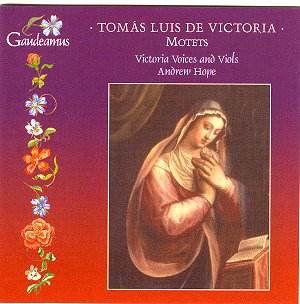Tomás Luis de Victoria was one of the last representatives
of the ‘prima prattica’, the polyphonic style which was dominant
in the period music history has labelled the ‘renaissance’. Musically
speaking, Spain and Portugal were isolated from the rest of Europe,
and that resulted in Spanish composers being rather conservative.
The fact that de Victoria went to Rome to study with Palestrina
will only have enhanced that tendency. In his composing, Palestrina
painstakingly followed the rulings of the Council of Trent, which
tried to find answers to some of the criticisms of the Reformation.
One of those criticisms was that liturgical music had become increasingly
complicated and, as a result, incomprehensible to the faithful.
In reply to that the Council asked for clarity of the musical
texture and asked composers to pay attention to the text and to
avoid anything that would obscure it.
The Counter Reformation also stressed the need for devotion. This
is certainly present in De Victoria’s motets, where it goes hand
in hand with the "passion, drama, intensity and radiance"
– thus Andrew Hope in his liner notes – which is characteristic
not only of De Victoria’s music, but of Spanish music in general.
Although De Victoria certainly paid attention to the text and
makes use of madrigalisms here and there, there is generally no
strong link between text and music. He rather concentrates on
creating an atmosphere which reflects the nature and meaning of
the text.
In the booklet, Andrew Hope explains the interpretational choices
he has made. Since most of the motets were composed during De
Victoria’s stay in Rome (roughly from 1565 to 1585) he has opted
for an Italian pronunciation. What is decisive, though, is not
where the music was composed, but where it was performed. But
it is reasonable to assume that motets composed in Rome were also
performed there – which doesn’t exclude the possibility that they
have been performed in Spain as well, after the composer’s return
to his fatherland.
But from there on Andrew Hope gets entangled in his own reasoning.
One would expect that an Italian pronunciation goes hand in hand
with an ‘Italian’, or more precise, ‘Roman’ style of performing,
which means predominantly ‘a cappella’. But instead he has chosen
to perform these motets with instruments. "Viols, harps and
theorbos were widely used instruments of the late Renaissance."
True, but that doesn’t say anything about where and when instruments
were used, and which instruments. "Although I know of no
evidence to suggest that Victoria conceived his motets to be performed
with voices and stringed instruments, the practice of instrumental
involvement in polyphony was both varied and widespread in Italy
and Spain".
But it is very unlikely that in Rome instruments were ever used
in liturgy. They were used in Spain, though: many cathedrals had
their own instrumental ensembles, which supported the singers
by playing ‘colla parte’ but also played motets without voices.
And the fact that there is no firm evidence that a composer had
a performance with instruments in mind, doesn’t necessarily make
such a performance historically unjustified. But the instruments
used in Spanish churches were predominantly wind instruments,
like cornet, sackbut and ‘bajón’, rather than viols as
are used here. In this light Andrew Hope’s statement: "I
am sure that Victoria would have come to similar conclusions"
seems nothing more than wishful thinking to me.
I could have lived with an ‘unhistorical’ performance if the performers
didn't try to justify their choices with shallow arguments. And
I could overlook even that if the performance was excellent. It
isn’t – on the contrary. The characteristics attributed to De
Victoria’s music in the booklet - "passion, drama, intensity
and radiance" – are totally absent here.
This performance is very down-to-earth and sober, with very little
text expression and contrast. The tempi are generally too brisk,
which makes it impossible to reveal the passion De Victoria's
music contains. And it is beyond me how the intense devotion of
pieces like 'Ave Maria' or 'Ave, Regina coelorum', texts which
belong to the heart of the Roman Catholic faith, can be performed
in such a neutral, bland way as is the case here.
Considering the things mentioned before it really doesn't matter
much that some of the singers use an annoying vibrato which undermines
the overall sound of the ensemble, and that the acoustics are
dry and lack the reverberation music like this needs.
Apart from the lack of historical evidence for the performance
practice, this is just a boring recording which lacks any excitement,
devotion or religious commitment - all of which are indispensable
attributes of any performance of Spanish religious music.
Johan van Veen
